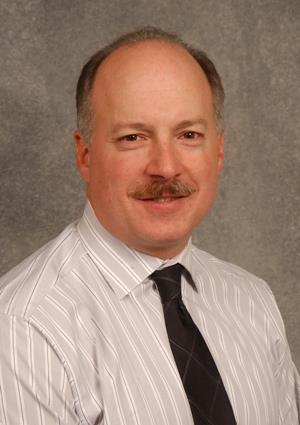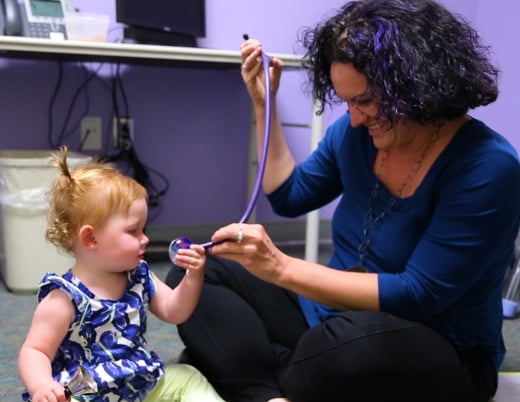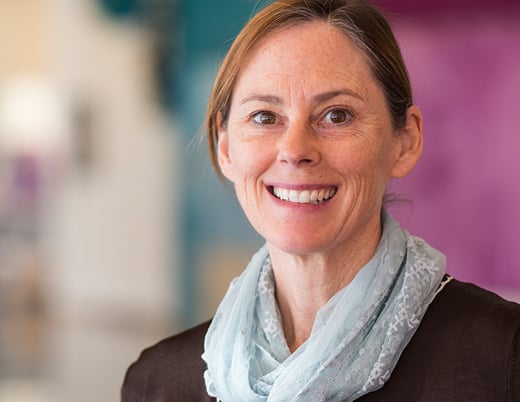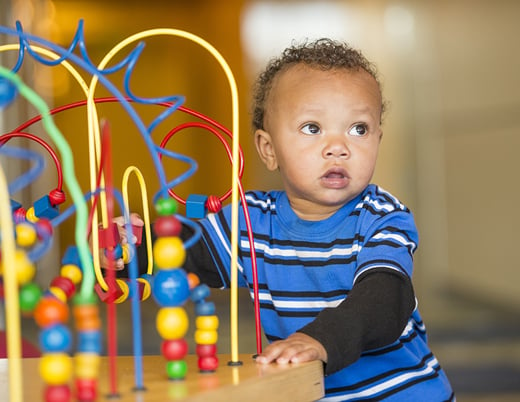Ana Villanueva is anxious. Understandably so: six weeks ago, her nephew was diagnosed with an aggressive adrenal cancer. Two weeks later, her 3-year-old son, Jaime, had a tumor removed from his neck.*
Jaime's tumor, a type called a "Gardner fibroma," wasn't cancerous, since that particular type can't spread. But Gardner fibromas can indicate a mutation of a gene called Adenomatous Polyposis Coli, or APC. Among other functions, APC helps control how cells divide. It's known as a "tumor suppressor" gene — which offers a good idea of what happens when something in APC goes wrong.
What happens is commonly known as familial adenomatous polyposis, or FAP, which causes a buildup of a type of polyps called adenomas in the gut. Left untreated, adenomas multiply and eventually turn to cancer — but it's preventable.
A team for all aspects of polyp-associated conditions
That's just one of the cases on the docket today at the Children's Hospital Colorado Pediatric Polyposis and Predisposition to Cancer Clinic — P3C2 for short.
"We're interested in children and families with inherited predisposition to colon and gastrointestinal tract cancers, most of whom have polyps," says pediatric gastroenterologist Edward Hoffenberg, MD, one of the Clinic's founding physicians.
Polyposis doesn't generally lead to cancer, but some forms come with a high chance of eventual malignancy, and the diseases that cause them tend to run in families. The Clinic was created to serve these families: gastroenterologists for polyps and bleeding and associated complications; genetic counselors to incorporate the genetic information of these diseases into the care of affected kids and their relatives; oncologists to treat the cancers that manifest outside the GI tract.
FAP, for example, can come with irregularities in the eye and a variety of skin tumors, like Jaime's Gardner fibroma. The polyposis program also ties in surgeons, endocrinologists, ophthalmologists and other specialists as needed. One of just a few programs in the nation built around its central triumvirate — gastroenterology, oncology and genetics — it harnesses a dedicated team for all aspects of polyp-associated conditions, all in one place.
Jaime might have FAP, or the fibroma might just be a one-time fluke. Genetic testing, the first step in the process, might offer some clarification.
Exploring the genetics of childhood polyposis
Afternoon sun spills through the consult room's big window, overlooking high clouds and the distant Rocky Mountains. Nobody's looking. Jaime and his 7-year-old brother Esteban — dressed in identical penny loafers and golf caps — play quietly. Esteban pushes a truck and sings softly in Spanish. Jaime climbs into his mother's lap, changes his mind and climbs out. A purple scar from the resection of the Gardner fibroma is still visible on his neck. Ana absently checks her phone. Her husband, Jorge, stares at his hands.
Kami Wolfe Schneider, MS, CGC, one of the clinic's two genetic counselors and the first specialist they'll see today, greets the family and sits down. "So what's your understanding of what you're here for today?"
Ana flinches and drops her phone. "We don't have a clue," she says.
For the next 45 minutes, Schneider walks Ana and Jorge, both of whom have a high school education, through a lot of information: what genes are, what a mutation does, how polyps form, how genetic testing works. She assures the parents that the team isn't worried about cancer — at least not for now. She answers questions.
Then she goes through family history. There's the cousin with adrenal cancer. An aunt had polyps. A grandma had colon cancer. A sister had a brain tumor. Breast cancer on one side. Stomach cancer on the other. Schneider sketches it out on a pad, a medical family tree known as a "pedigree."
She talks Ana and Jorge through the testing. If found, a mutation in APC could offer a good idea of what's to come — although a negative result wouldn't necessarily mean a mutation is not there. There's also the fact that, even if Jaime has an APC mutation, polyps typically won't start developing before age 10. He's too young to consent to the testing now, but the results will potentially impact the rest of his life.
"Once you know," Schneider counsels, "you can't take it back."
Ana doesn't hesitate. "We want to do it."
"It's up to us to be the leaders in taking care of these children."
—Kami Wolfe Schneider, MS, CGC
Genetic counselor, Center for Cancer and Blood Disorders
A better classification for juvenile polyposis syndrome
The condition the polyposis program's team most often sees is juvenile polyposis syndrome, or JPS. Unlike FAP — which is linked almost invariably to APC mutations — JPS has many potential causes. Some forms are linked to certain genes, but more than 60% have no known genetic link.
Seth Septer, DO, one of the Clinic's two pediatric gastroenterologists, co-leads a national study with investigators at the Cleveland Clinic to better classify the many forms of JPS. Schneider has also been closely involved. In the long run, they hope to get a better understanding of what risks these diseases pose, and how to follow patients not just while they're young, but over the course of their lives.
"We're looking at which patients with juvenile polyps seem to be at highest risk of developing more polyps or colorectal cancers later in life," says Dr. Septer. "The hope is to guide how we diagnose these diseases in the future."
"It's really important to understand these conditions," says Schneider. "Being in a clinic connected internationally with other experts in this area, it's up to us to be the leaders in taking care of these children."
Staying ahead of the treatment curve
Right now, treatment options are limited: polyp removal and, if polyps become too numerous, removing the colon. Even there, the team is ahead of the curve. Early adopters of video capsule technology to screen for polyps of the small bowel 15 years ago, the Clinic's GI team was more recently one of the first to use balloon enteroscopy, a system of balloons that prop open the small bowel to allow a scope to snake its way in.
This new technique allows endoscopy expert Robert Kramer, MD, to remove polyps from much deeper in the GI tract than standard endoscopy can reach. Previously, these procedures had required invasive surgery.
Even in cases where the colon must be removed — an inevitability for kids with FAP — team effort keeps impact to quality of life at a minimum. Social workers and ostomy nurses educate and assist kids and families with coping, while dedicated surgeons plan, execute and manage minimally invasive operations.
"We limit the number of surgeons involved," says pediatric surgeon David Partrick, MD, the Clinic's go-to for colectomy. He performs the entire procedure laproscopically, making only four small incisions. "These are complicated operations, so you want someone who does them a lot. Having that regular practice is a big advantage."
From reaction to prevention
In an exam room around the corner from the consult room, Dr. Septer is wrapping up an appointment with 10-year-old Hannah Bruckner, who has a history of desmoid skin tumors. That's another potential indication of FAP, although testing has so far come back negative. Still, the risk is high enough for bi-yearly follow-up and colonoscopy.
"We'll see you in two years," Dr. Septer says. "In the meantime, let your mom know if you see any blood in your stool, okay?"
She makes a face and turns to her mom, Judy.
"Your poop," Judy clarifies.
Hannah's older sister, Brianna, heaves a heavy sigh and lowers her face into her hands. "Oh, gross."
"That's it," Hannah announces. "I'm not pooping for the next two years."
Dr. Septer chuckles. "Then we'll see you a lot sooner."
The team regroups in a workroom down the hall. Hannah is adopted and has little known biological family history. Given that, and the negative test results, Hannah is a good candidate for an ongoing gene-searching study at a cancer institute Schneider has worked with before. Maybe they can detect something the testing so far has missed.
Meanwhile, Jaime and his family are waiting for Dr. Septer to do a preliminary examination and take questions. That's the next stop: drawing blood for genetic testing. Results will come back in 3 to 4 weeks, at which point he'll meet with the genetic counselor again and plan next steps.
For Jaime, there's real hope that the Program's ongoing clinical trials may produce therapies to stop polyps from forming. By the time he's 10, it's entirely possible that the medical landscape will have changed for kids predisposed to polyps and colon cancers. The polyposis program at Children's Colorado is leading the way.
For now, though, early intervention is key.
"These kids are at risk, but when there's no definitive diagnosis, there can be barriers to getting the regular follow-up care they need," says Dr. Hoffenberg. "That's something we're working on — harnessing our recordkeeping technology to keep track of these kids and ensure they receive follow-up monitoring. We're trying to get from reaction to prevention."
"If you take preventive steps," adds Schneider, "these children are going to have a better quality of life."
* Names and details have been changed to protect patient privacy.
Featured Researchers

Kami Wolfe Schneider, MS, CGC
Senior instructor
Pediatrics-Clinical Genetics and Metabolism
University of Colorado School of Medicine

Seth Septer, DO
Pediatric gastroenterologist
Digestive Health Institute
Children's Hospital Colorado
Associate professor
Pediatrics-Gastroenterology, Hepatology and Nutrition
University of Colorado School of Medicine

David Partrick, MD
Director of Surgical Endoscopy for Infants and Children
Pediatric Surgery
Children's Hospital Colorado
Professor
Surgery-Peds Surgery
University of Colorado School of Medicine





 720-777-0123
720-777-0123










